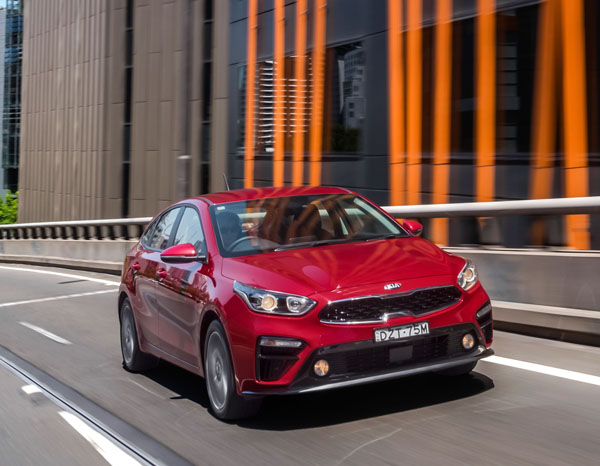
Use by Kia of the word ‘sport’ for the Cerato 2.0 seems an odd misuse too. Sport in automotive terms conjures up something special in a vehicle, especially to do with performance.
In the case of the Cerato 2.0 Sport hatchback test vehicle at $25,790, plus on roads, the tag has merely nudged out the Si and SLi with this and Sport+ models. Nothing special here. Those wanting a genuine sporty Kia had better head for the Cerato GT, on the way shelling out an extra seven grand for the pleasure.
Drive Mode Select, six airbags, tyre pressure monitor, speed limiter, six-way driver seat adjustment, cruise control, 8-inch touchscreen infotainment display, Apple CarPlay and Android Auto with voice recognition, six-speaker DAB digital radio with Bluetooth connectivity, manual air-conditioning and power windows with driver auto-down.
The Sport model adds 17-inch alloy wheels, satellite navigation with SUNA live traffic and 10 years Mapcare, premium steering wheel and shift knob, aero blade wipers and sport-patterned cloth-trim seats.
STYLING
Designers turned to the Kia Stinger sports sedan, especially up front, for cues to the Cerato’s looks. The result is some of the best in the segment. The long bonnet links with a roofline that slopes gradually to a short rear deck creating a fastback effect.
Kia’s signature ‘tiger nose’ grille and lower air intakes, black diffuser, a single chrome exhaust tip at the rear, upper and lower mesh grilles up front, and a roof-top spoiler present a sporty character. The car rolls on 17-inch alloy wheels.
Aerodynamics is the winner all round with the drag co-efficient bettered to Cd 0.27 over the Cd 0.28 of its predecessor.
INTERIOR
Like the sedan versions, the newly revamped hatch gets a wider dash to promote a feeling of roominess. The spacious ambience extends to the back where generous leg room helps to keep occupants in comfort.
The driver’s seat misses out on electric power for its six-way adjustment, including height. Storage includes two cupholders in the fold-down rear armrest and another two in the front.
A deep centre console bin includes a USB charging port, which is replicated under the dash with a USB media port and a 12-volt outlet.
At 428 litres, boot space is less than the Cerato sedan, but the hatchback comes into its own with more usable load-through space with the 40:60 split seatbacks are folded. A space-saver spare wheel is stowed under the floor.
INFOTAINMENT
An 8-inch touchscreen infotainment display, Apple CarPlay and Android Auto with voice recognition, six-speaker DAB digital radio with Bluetooth connectivity, satellite navigation with SUNA live traffic updates and 10-year Mapcare gives the Cerato the edge against others in the market segment.
ENGINES / TRANSMISSIONS
Across the range all Ceratos retain the proven Nu 2.0-litre four-cylinder MPI motor putting out 112 kW of power and 192 Nm of torque, so there is no performance advantage to the Sport variant over the entry-level S. Why bother?
Drive to the front wheels is through Kia’s in-house six-speed automatic or six-speed manual transmissions.
SAFETY
Across the board Kia Cerato features autonomous emergency braking, forward collision warning, lane keep assist, rear view camera with dynamic guidelines, driver attention alert, front and rear parking sensors,
These days for a vehicle to earn a top five-star rating the emergency braking system needs to be able to detect pedestrians and cyclists.
The Cerato Sport does not, so is rated four stars. This can be rectified by optioning the safety pack at very reasonable $1000. It adds adaptive cruise control and folding mirrors, blind-spot monitoring, rear cross-traffic alert, and top-notch Fusion II AEB with pedestrian and cyclist avoidance, boosting the ANCAP rating from four to five stars.
DRIVING
All new Ceratos, bar the top-of-the-range GT 1.6 Turbo, rely on Kia’s tried and true 2.0 four-cylinder MPI petrol engine, which runs quietly at city street speeds but can become a bit gruff when urged.
The six-speed auto gearbox incorporates Kia’s Drive Mode Select system, giving the driver the chance to dial in Eco, Comfort, Sport or Smart characteristics to engine performance.
‘Smart’ is claimed to monitor the driver’s habits, automatically adapting to inputs, shifting between the other three modes depending on driving conditions. In this mode, the test car lived comfortably under 8 litres per 100 kilometres fuel consumption in mixed driving – nothing too strenuous, equating to the maker’s claims.
Ride and handling are better than many rivals, which goes to illustrate the advantage of Kia’s Aussie engineers running the rule over local suspension and chassis settings.
For a smallish car – 4.6 m long and 1.8 m wide – the Cerato has impressive shoulder width, and leg and head room.
SUMMING UP
There is basically nothing wrong with the Cerato Sport, it’s just that it doesn’t live up to the ‘sporting’ tag. On the plus side, it is well specced and similarly priced and there’s always the seven-year warranty at the owner’s back.
AT A GLANCE
MODEL LINE-UP
Kia Cerato S: $20,990 (manual), $24,290 (automatic)
Kia Cerato Sport: $25,790 (automatic)
Kia Cerato Sport+: $28,290 (automatic)
Kia Cerato GT Turbo: $32,990 (automatic)
These prices do not include dealer or government charges. Contact your local Kia dealer for drive-away prices.
SPECIFICATIONS (Kia Cerato Sport 2.0L MPI petrol automatic, hatchback)
Capacity: 1999 cc
Configuration: 4-cylinder in-line, DOHC MPI, six-speed automatic
Maximum Power: 112 kW @ 6200 rpm
Maximum Torque: 192 Nm @ 4000 rpm
Fuel type: Petrol, 91 RON
Combined Cycle (ADR 81/01): 7.4 litres per 100 km
CO2 emissions: 167 g/km
DRIVELINE:
Drivetrain: 6-speed automatic
DIMENSIONS, WEIGHT AND CAPACITIES:
Length: 4640 mm
Width: 1800 mm
Height: 1440 mm
Wheelbase: 2700 mm
Tare weight: 1320 kg
Fuel Tank Capacity: 50 litres
BRAKES:
Front: Ventilated disc
Rear: Disc
WARRANTY:
7 years / unlimited kilometres